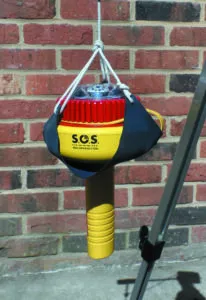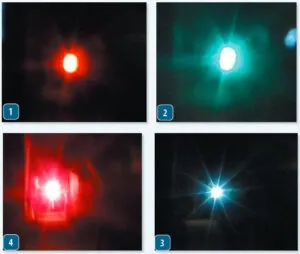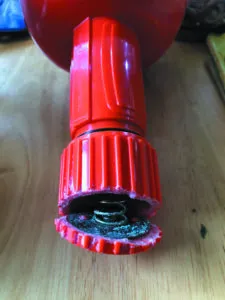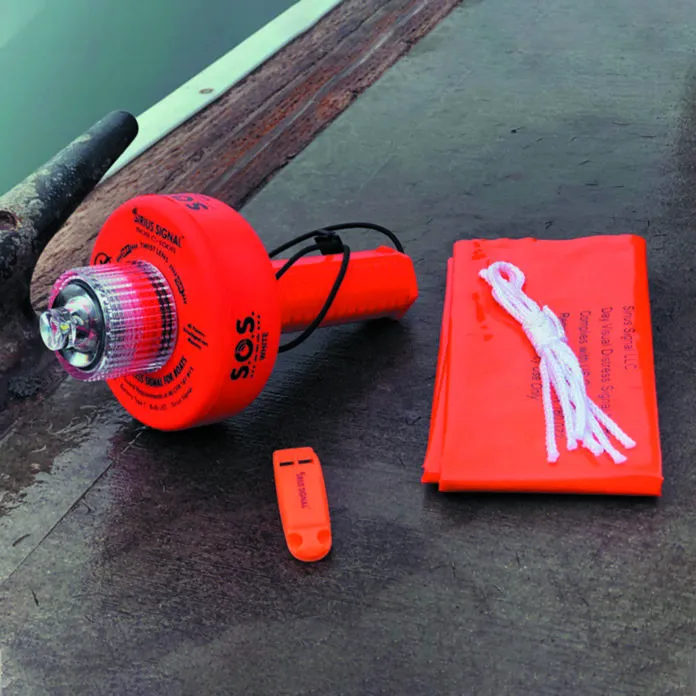The first USCG approved electronic beacons entered the market in 2015 (46 CFR 161.013). Classified as electronic visual distress signaling devices (eVDSD), they emit a slow flashing white SOS (three short, three long, three short) distress signal for more than six hours. While not as bright as pyrotechnic flares—75 candela vs. 680 candela—they are still said to be visible for up to 10 miles, the result of a lens that concentrates the light into 2 narrow beams—a horizontal band and a vertical beam—just 6 degrees wide. Six hours is a big improvement over the brief three minute burn of a pyrotechnic flare. All the same, there were concerns that they were not easily identified and could be confused with shore lights, net markers, and aids to navigation.
On December 21, 2018, the USCG announced the acceptance of a new signaling device standard, RTCM Standard 13200.0. The new beacons flash SOS in alternating colors (red/orange and cyan, which is greenish blue) about 2.7 times faster. While flashing white lights are used for many things, including marking fishing nets, studies showed that the alternating color pattern was far more detectable and recognizable as a distress signal. Devices meeting the RTCM standard automatically meet the existing USCG electronic distress signal standard.
Any high intensity light flashing 50- 70 times per minute is recognized as a distress signal. However, a flashing anchor light does not meet the USCG carriage requirements for a night distress signal. It must have a separate battery source and storm damage is a possibility. And please don’t use a strobe as a high visibility anchor light; this is a violation of the rules and really annoying to fellow cruisers.

WHAT WE TESTED
We compared the Orion 547, Sirius Signal C-1003, Sirius Signal C-1002, the ACR C-Light, and hand-held flares for visibility, recognizability at night, and general utility. All three manufacturers are established businesses in distress signalling.
HOW WE TESTED
We confirmed the light output angle by measuring against a white background. We lit them up at night and observed them from up to 1.2 miles, judging both visibility and whether they are clearly distinguishable from other lights in the distance. We tried mounting them on the boat in different ways, noting ease and sturdiness, and relating the resulting angles to the light output range noted above. We left them hanging in a day-long pouring rain to test for water intrusion.
THE BASICS
We elected to test nighttime visibility down a suburban sidewalk, in part because setting off distress signals on the beach seemed like asking for trouble, even with appropriate notifications. An important consequence was that the signal lights were surrounded by a background of driveway lights, which brought into sharp focus just how much more noticeable they were than flares. Each time a tester started a new light it was obvious to our observer, and even more so with the Sirius C-1002.
VALUE GUIDE: DISTRESS SIGNALLING LIGHTS
The pyrotechnic flare was brighter, but from a distance, it could still be mistaken from the background light. The SOS lights were conspicuous against the backlight, and if a sailor checked the flashing frequency to compare it to aids to navigation, as we commonly do, the universal dot-dot-dot dash-dash-dash dot-dot-dot SOS Morse code pattern would be apparent.
Pyrotechnic flares and electronic beacons are different and you can carry both. The downsides of electronic signaling devices include their poor visibility in daylight (a flag or other signaling means is required for daytime), higher initial cost, less brightness, and limited visibility from the air. The pre-RTCM 13200.0 models concentrate the beam along the horizon and have only a narrow vertical beam.
TECH SPECS: SOS LIGHT STANDARDS
Advantages include no expiration date (the batteries must be in date), no disposal problems, longer signal time (6-8 hours vs. 4 x 6 minutes), and lower cost over the long term. Eliminating safety hazards inherent in pyrotechnics, including a constant plume of red hot slag, was a large part of the US Coast Guard’s impetus for developing the eVDSD standard. Because a handheld flare must be held over the side of the boat, half of the light output is typically blocked by the holder’s body and boat superstructure. An electronic beacon or flashlight does not ruin the user’s night vision the way a flare does.
All of the units tested seemed rugged, well-sealed, and able to take a licking. None of them leaked, we had no failures, except one near miss with a leaking battery.

In terms of functionality, the chief differences between the new RTCM Standard 1320.0 lights and the U.S. Coast Guard standard lights (46 CFR 161.013) are the rate of flashing, the arc of visible light, and the color of the flashes. Both types flash out the common SOS pattern, but the newer RTCM lights are bicolor, flash at a faster rate, have a broader arc of visibility and feature an infrared light (IR) that can be detected with night vision (IR) equipment. The adjacent photos illustrate how the lights appeared from a distance of 1.2 miles to our observers.
1. The rapid Sirius C-1002 orange/red “dots” are conspicuous.
2. The Sirius C-1002 cyan dashes are slightly brighter because the eye sees green best. The alternating colors, increased frequency, and increased brightness make The C-1002 more visible than plain white beacons.
3. The Sirius C-1003 white flashing light seemed about 25 percent less bright, but still stood out against a cluttered skyline. A nonsailor might not recognize the SOS pattern.
4. The Orion handheld signal flares are brighter, but not more noticeable because the burst is short-lived.
RIGGING THE LIGHT
Ads often show a boater holding the electronic beacon aloft, waving it back and forth, as though that’s going to make any difference at over 1/4 mile. Try just holding your hand over your head for 10 minutes; it turns to lead. Finally, tilting any of the beacons reduces the light output in some directions. Hanging it in the rigging will seem natural for most sailors, but all of the units required some modification do this.
OBSERVATIONS
Our testing elicited several general observations on the care and use of electronic distress lights—as well as some light-specific comments.
• Do not hang the unit too high. The more line that is attached to the unit, the more the unit will sway. Yes, in theory a high rigging point gives more range, but realistically it won’t be recognizable as a distress signal for more than a few miles, so anywhere above the cabintop is high enough.
• Do hang the light well above the sight line. The light is blinding to night vision (about 1,000-10,000 times brighter than a dark-adapted eye should be exposed to).
• Replace the hanging bungee cord with non-stretch line. We rigged the Orion 547 under the boom, tensioned it to the deck, and even in a 10-15 knot chop it gyrated like a boxer’s speed bag. We replaced the bungee with nonstretch line top and bottom, and it held steady.

In the midst of a crisis the skipper hands you the electronic beacon and says “Rig this.” Typically, you’ll have just three questions: “Where do I hang it, where do I attached the rope, and how do I turn it on?” While all of the lights we tested were simple to turn on, only the Orion unit comes with hanging fittings that will position it vertically. This is not a detail you should be struggling with in the dark when it’s urgent.
If you replace the factory bungee on the Orion 547 with 550 parachute cord, and use a non-stretch line above and below, and it will hang straight. Slide the float down on the Sirius C-1003 to reveal the hanging clips, cut the factory bungee away, and replace with a figure eight loop of non-stretch cord. Slide the float back up and it will hang straight.
The Sirius Signal C-1002 requires a few minutes more work since there is only one hanging point and it is offset, causing the light to hang at a 25 degree angle. Using a hot knife, cut an equilateral triangle, about 7-9 inches on a side, from canvas or sail cloth, squaring off the last 1/2-inch of the tips. Glue (polyurethane sealant works well) or sew a doubler about 1 ½-inches on a side to reinforce the corners. Punch a hanging hole in each corner; grommets would be even better. Cut a 1 1/4-inch hole in the center for the handle. Rig 3 equal length lines to a central point (about 8 inches) and join in an eye (see photo page 16).
The same cloth bridle should work for the ACR ResQflare, but the lack of a float means the size of the handle hole will be smaller and better fitted.
Now the lights will hang straight with minimal swing. We are not sure why these details were not addressed in otherwise solid products.
ORION 547
• The handle is 2 1/16 inches in diameter, which is too fat for rod holders. You could install a vertical 6-inch holder made from appropriate sized tubing.
ACR RESQFLARE AND SIRIUS C-1003
• The ACR ResQFlare has no provision for hanging.
• The Sirius C-1003 hangs at a severe angle from the factory bungee. Cut away the bungee and replace it with bridle.
• Vertical rod holder. The ACR and Sirius lights have a smaller handle (1 5/8- inch diameter) that will fit in most rod holders, but the holder must be near vertical and located on the cabin roof, like the rocket launchers common on sport and charter fishing boats. If tilted, the light is only visible at two spots on the horizon, where the planes of the output light and horizon intersect.
SIRIUS SIGNAL C-1002
• Bridle. With a 100-degree vertical output (a solid 200 degree arc) this light is less vulnerable to tilting, but if placed in a standard rod holder (30-degree tilt) or rigged from the supplied holes (20- 25 degree tilt) it will only be visible for a 220-degree horizontal arc, and invisible for the remaining 140 degrees of the horizontal plane.
• Vertical rod holder will work. The light’s wider vertical arc (+90 degrees/ -10 degrees) will keep it visible with moderate rolling.
BATTERY SHELF LIFE
Although the beacons have no expiration date, their batteries do. Alkaline batteries are typically good for 5-10 years and lithium batteries are good for 10 years. They are marked. Orion and Sirius recommend annual replacement of alkaline batteries and Sirius recommends 5-year replacement for lithium batteries.
Always put a sticker on the outside of the beacon, reminding you of the battery installation and replacement date, just like a flare. Inspect the light for function every spring. Battery replacement cost is about $3 for alkaline and $15 for lithium.
FORM FACTOR
We read complaints that these lights are heavy and bulky. The largest of the group, the Orion 547, fit conveniently in our ammo case along with handheld flares, a distress flag, and meteor launcher, so this was not a chief concern of ours. We’re not going to hold it in our hand, so weight is a minor factor (so long as it floats). If you have vertical rod holder mounted high on the boat (unlikely on a sailboat), the more slender handle of the Sirius signal and ACR lights will fit in it.
VISIBILITY
Flares are brighter, but from more than a mile away they can easily be mistaken for running lights or shore lights. In fact, our strong impression when taking pictures was that flashing lights, even the relatively more dim white-only versions, are far more recognizable than a flare, and that the faster red-green-red flashing of the Sirius C-1002 couldn’t easily be mistaken for anything else.
At 1.2 miles colors became white light, but the rhythmic blinking of the SOS beacons still stood out, even against scattered background lights. We feel it is much more likely that another sailor would react to an SOS flasher than a flare. Interviews with landsman, on the other hand, suggest they might not recognize the SOS pattern.
MOB LIGHT?
In a perfect world, we would all carry purpose-built MOB poles. We don’t, but it occurs to us that these lights float, produce a strong, identifiable signal, and might be darn useful for marking the position of an MOB at night.
The key to this dual functionality is to store it where it can be deployed in a moment, perhaps in a pouch connected to the ubiquitous horseshoe buoy. We leave a 4-foot line with a clip attached to our SOS light, both for rigging and for tying to a horseshoe float (See PS January 2006, “Slings, Scoops and Ladders”).
BRIGHT FLASHLIGHT
We also recommend a strong flashlight with a focusable beam. Like a handheld flare, it can be used to direct rescuers or attract attention without the spark hazard and without blinding the user’s night vision (“Practical Sailor Sheds Some Light on LED Flashlights,” December 2007).

You may also want to consider laser signaling devices for long range signaling (see PS February 2004 “Review: Rescue Laser Flare”; PS September 2013, “Odeo Laser Flare”; PS April 2011 “PS Tests New Green Laser Flare”). Note, however that RTCM Standard 13200.0 expressly excludes lasers from electronic visual distress signaling devices.
U.S. COAST GUARD COMPLIANT
The following devices meet U.S. Coast Guard standards.
ORION 547
Powered by two D batteries, the Orion was the heaviest and bulkiest of the group. It won’t fit in a rod holder. It seemed rugged and did the job out of the box. Bad batteries leaked and ruined the battery cap (see adjacent photo). When we contacted Orion anonymously, the company charged us nothing for a replacement.
Bottom line: Recommended.
ACR RESQFLARE
Powered by 2 C batteries, the ACR is compact. It fits a standard rod holder. The 20 hour run time is impressive. However, it has no hanging point.
Bottom line: The lack of any hanging point is a key deficiency.
SIRIUS C-1003
The Sirius C-1003 is very similar to the Orion 547, but because it is powered by two C batteries, it is lighter and the handle is small enough to fit standard rod holders. Replace the factory bungee cord with a figure eight loop of non-stretch cord and it will hang straight (see “Modifying the Orion 547 Light”).
Bottom line: Recommended.
RTCM DISTRESS LIGHTS
Only one of our test lights met the new RTCM standard, which has both Coast Guard and international approval.
SIRIUS C-1002
The alternating red/blue/red (technically orange-red/cyan/orange-red) signal is considerably brighter and more recognizable. We like the full hemisphere light output; this seems far more dependable when the boat is rolling.
The vertical arc also dramatically increases visibility to helicopters, and the SOS pulse includes an infared signal (IR), calibrated to be highly visible to night vision gear. In ideal conditions an SAR team with night vision can see the light up to 20 miles away, but rain or fog can greatly reduce that ranges.
The C-1002 comes with a cell phone app that includes the ability to check battery condition, turn it on and off remotely via Bluetooth, and activate a float plan that will notify up to five people if you are overdue. It also maintains a GPS position record. We’re annoyed that there is no provision for hanging, but like that it fits in a rod holder. It runs on two CR123 batteries, which are widely available and less prone to leakage, though harder to find abroad than the C and D batteries used in the other lights in our test.
Bottom line: Our Best Choice in an eVDSD is also the highest priced.
PERSONAL DISTRESS LIGHTS
The following devices were tested for comparison purposes only.
ACR C-LIGHT
This is an older out-of-production model and is designed for a different purpose— as a personal MOB light. We only tested it to provide a comparison point. It has a much smaller range than the eVDSD lights, and it did not flash the SOS codes. On the other hand, if you are out on your dinghy or kayak, a personal light that can flash SOS might prove useful. Some personal distress beacons, like the C-Light, have a lens on the top. In a pinch, they are also useful as flashlights (see PS February 2016 “Which MOB lights Shine Bright?”).
Bottom line: We recommend personal distress lights for PFDs used at night.
CONCLUSIONS
We originally bought an electric distress light because we were sick of buying flares that only last two seasons.
We were pleasantly surprised by how well even the basic eVDSD devices stood out against background lights. The Orion 547, Sirius Signal C-1003, and Sirius Signal C-1002 all outperformed flares, with much longer run times and greater recognizability. We like that they can be used to mark an MOB and are safe in use. For long–term boaters, the Orion 547 and Sirius C-1003 are also more economical than flares, since fresh batteries every few years is all that is required, rather than replacement.
In our conversations with the US Coast Guard regarding the new electronic visual distress signaling devices (eVDSDs), they were quick to point out that an eVDSD is only one component of the vessel’s complete distress system. Communications equipment, including personal locator beacons (PLBs), emergency position indicating radio beacons (EPIRBs), digital selective calling VHF radios (VHF-DSC), and even cell phones are all useful tools for alerting response assets in a distress situation, making you easier to locate and rescue in a timely manner. Flares, smoke, flags and soundproducing devices still have a place in the complete signaling kit. All of these can be vital in a worst case distress scenario.
Among the electronic beacons, the Sirius Signal C-1002 is certainly bestin- class. It is brighter than the others, nearly as visible as a flare and far more recognizable, has a wide 200 degree light angle to allow for rolling, and the cell phone app is loaded with handy features.
When traveling farther offshore I carried a heavier kit, with aerial flares, smoke, and a stack of handhelds. We think the eVDSD fits in that kit as well, where the multi-color flash, sustained flashing period (even longer with spare batteries!), and improved visibility to SAR assets will matter. They are certainly safer in life raft situation, where pyrotechnic flares are a hazard.
Finally, spread the word about the alternating orange/red and cyan flashes on the water for a distress call. It’s new.
New distress beacons feature lights that flash on infrared spectrum.
Two types of lights have been recognized by regulatory bodies as acceptable substitutes for pyrotechnics. Sailors should familiarize themselves with key differences and choose one that best fits their needs.
1. The Sirius C1003 and C1002 (on left) comply with the RTCM Standard 13200.0; the C1002 complies with the USCG standard (46 CFR 16103).
2. The new RTCM SOS beacon lights flash alternately red/orange and cyan in the familiar Morse code short/long (dot-dash) pattern for SOS. They also flash in the infrared, making them more visible to night vision equipment.
3. The plain white eVDSD lights flash the same pattern, but white only, and about 3 times slower.
USCG ELECTRIC DISTRESS SIGNALS
§ 161.013-3 General Performance Requirements.
(a) Each electric light must:
(1) Emit a white light which meets the intensity requirements of § 161.013-5; (peak intensity 75 candelas, 25 candelas if tipped 4 degrees)
(2) Be capable of automatic signaling in a manner which meets the requirements of § 161.013-7;
(i) Each short flash must have a duration of 1/3 second;
(ii) Each long flash must have a duration of 1 second;
(iii) The dark period between each short flash must have a duration of 1/3 second;
(iv) The dark period between each long flash must have a duration of 1/3 second;
(v) The dark period between each letter must have a duration of 2 seconds;
(vi) The dark period between each SO- S signal must have a duration of 3 seconds.
(3) Contain an independent power source which meets the requirements of § 161.013-9 [6 hours];
(4) Float in fresh water with the lens surface at or above the surface of the water;
(5) Be equipped with a waterproof switch; and
(6) Meet the requirement of paragraphs (a) (1) through (4) of this section after floating for at least 72 hours followed by submersion in 5% by weight sodium chloride solution for at least 2 hours.
(b) The electric light may not be equipped with a switch mechanism which permits continuous display of a beam of light except that the light may be equipped with a switch which returns to the off position when pressure is released.
EXCEPTIONS
The requirements pertain to vessels used on coastal waters or the Great Lakes or on any body of water with a passageway to the sea at least two miles wide.
The following boats are NOT required to carry visual distress signals (but in many cases it is still a good idea to do so):
• Boats participating in organized events like races, regattas or marine parades
• Open sailboats less than 26 feet in length that are not equipped with mechanical engine propulsion
• Manually-propelled boats
RTCM STANDARD 13200.0 (SUMMARY NOTES)
• No lasers.
• The eVDSD shall be a single, selfcontained, handheld device that displays a visible, two-color, flashing signal, plus a near-infrared component for detection via night vision goggles that are equipped with Aviator’s Night Vision Imaging System (ANVIS) Class B Minus Blue Filters. The visual signal shall be displayed in a hemispherical pattern.
• Flash pattern of RTCM more than twice as fast as USCG (3.375 vs. 7.333 seconds).
•Must function for two hours.





































ya sure change canvas color every season,, never
Are there any RTCM Standard 13200.0 compliant eVDSD devices on the market yet in addition to the Sirius Signal C-1002?
Not that we are aware of at this time. I just did a quick search, and I asked other manufacturers at the last boat show. Just the one model.
The USCG does not require compliance with the RTCM standard, only compliance with the basic USCG eVDSD standard. Transport Canada requires compliance with the RTCM standard, and the standard is an improvement over the more basic USCG standard. It is brighter, the colors more distinctive, and the vertical signal component is optimized for air search using night vision equipment.